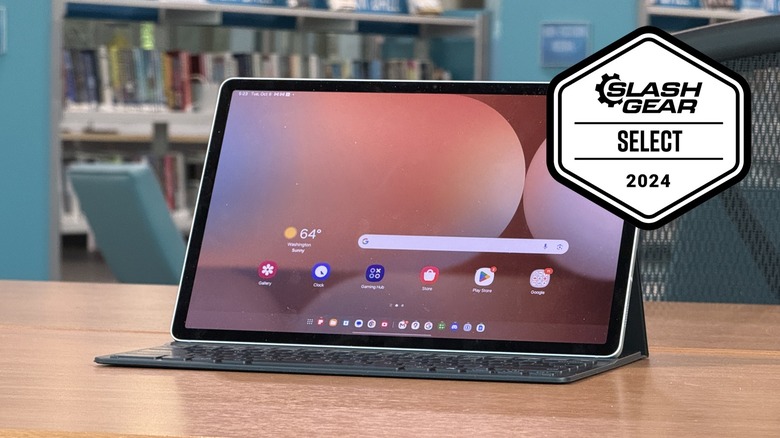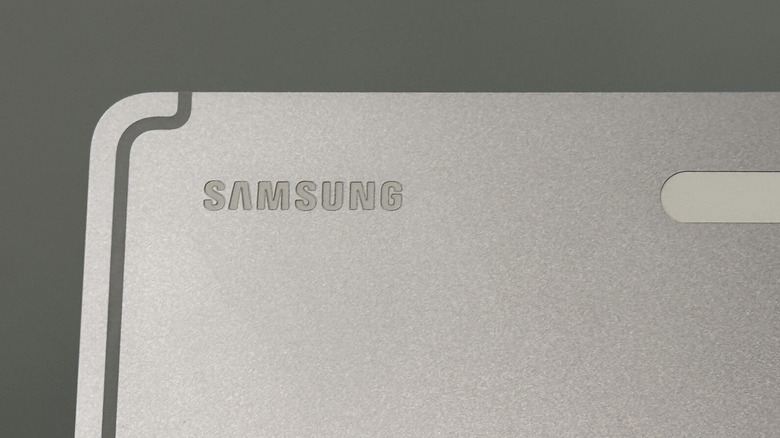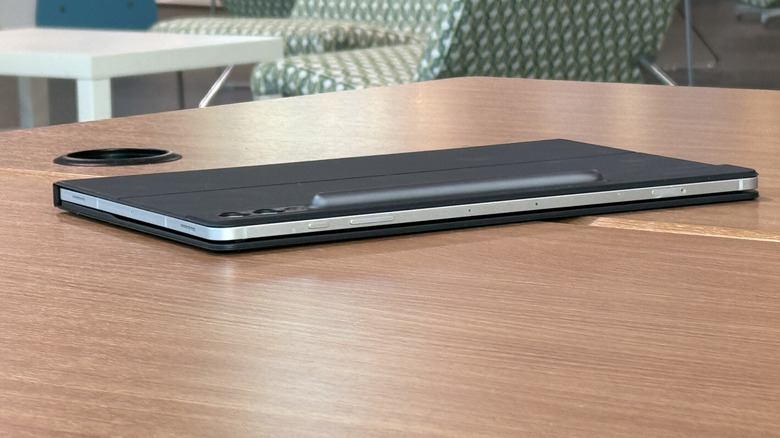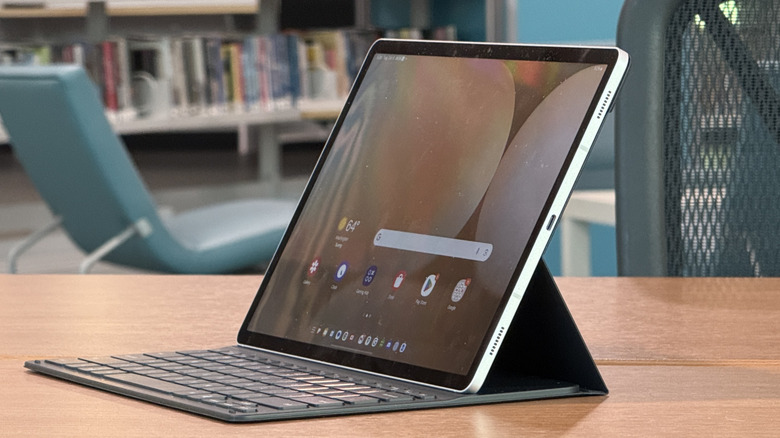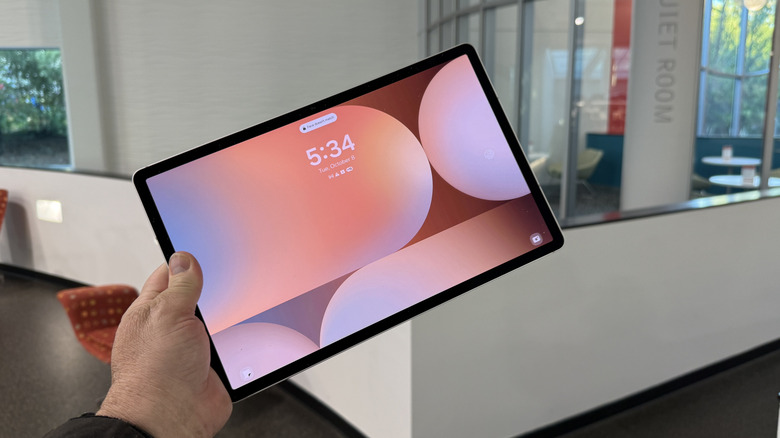Samsung Galaxy Tab S10 Plus Review: Premium Android Tablet With A Price To Match
- Extremely thin and light
- Excellent display
- Good battery life
- Included S Pen
- AI features starting to take shape
- Keyboard not included
- Considerable Cost
We may receive a commission on purchases made from links.
In the world of Android tablets, there is a push to make a productivity machine that can compete with a laptop but be as light and portable as a tablet. Samsung in particular has been leading that charge for many years. There've been long periods of time where the only real viable choice for a high-end Android tablet was one made by Samsung.
Productivity tablets in particular are a weird sort of niche for Android tablet users. If you ask around, you'll find a ton of uses from the education to the construction industries. It used to be that Android tablets in particular would just be glorified Netflix boxes, good for consumption and that was the end of the list.
These days, with processing power relatively easy to come by, the "productivity tablet" is becoming a force to be reckoned with. The advantages are obvious — mobile operating systems are what most people spend most of their time on, so why shouldn't that come in a larger form factor that's good for getting work done too?
At its most recent fall event, Samsung launched a pair of new tablets — the Galaxy Tab S10+ and the Tab S10 Ultra. I've been using a Samsung Galaxy Tab S10 Plus sample, provided my Samsung, in my office for around two weeks, and this is my full review.
Plus and Ultra
Right off the bat, something seems a little weird in that Samsung launched the Galaxy Tab S10+ (or Galaxy Tab S10 Plus, however you prefer), and the Tab S10 Ultra. In the past, we've seen a trio of tablets, starting with a non-plus version. What's a little peculiar is when you start with a plus edition, you start to wonder "plus compared to what?" and that's where Samsung left us scratching our collective heads.
Regardless, here what you get in the Tab S10+. You get a 12.4-inch gorgeous screen at 1,752 x 2,800 pixels and 120Hz refresh rate. The tablet comes in 256 GB or 512 GB configurations, both with 12GB of RAM. But there's one more interesting part about the internals.
You also get a Mediatek Dimensity 9300+ processor, which is a first for a U.S.-based flagship. Qualcomm's Snapdragon processors typically power Samsung devices in the U.S., but a switch to Mediatek could prove to be an interesting one. At the very least it should spur Qualcomm into improving its own processors now that there's real competition in the space. It'll be exciting to see how this develops going forward.
Extremely thin
In addition to the MediaTek processor and all the other specifications, this tablet has a 10,090 mAh battery, which is pretty large in the tablet space, especially considering how thin the table is. It's just 5.6mm thick, which is pretty impressive considering the amount of power this tablet packs. The type cover adds some bulk to it, but overall, this is an impressively thin and light tablet at 571 grams.
Around the sides of the device, when it landscape orientation, there's a power and volume rocker in the upper left-hand corner, and a microSD card holder in the upper right corner. There are four side-firing speaker grilles on the top and bottom of each side and a USB Type C port on the right for power and data transfer.
On the back, there are dual cameras that you should not use. There's a 13-megapixel main camera and an 8-megapixel ultrawide camera. The front facing 12-megapixel selfie camera is just fine for video calling.
Productivity comes extra
As with Samsung Galaxy Tabs in the past, the Galaxy Tab S10 Plus and Ultra both ship with the stylus in the box. That stylus attaches to the back of the tablet magnetically, and for those who want to draw and/or make fine selections, that's a nice addition. Personally, I rarely use the stylus on any tablet, but that's me. I would much rather buy a tablet with a keyboard in the box — oh and by the way, that's not the case here. The keyboard is sold separately.
This is just as surprising as it is welcome — which is to say in both cases, not at all. But Samsung is going a step further by marketing the fact that you have AI at the press of a button, without actually giving you the button to press. Never mind that this is marketed to be a productivity tablet that is basically impossible to be productive with. Maybe I'm an odd use case; maybe there are a ton of people out there with Bluetooth keyboards that they just refuse to give up. But the worst part is, the keyboard isn't even all that good.
To be fair, I don't mind it all that much, but I like slim, low-profile keyboards with minimal travel. But when you compare this keyboard to something like Apple's Magic Keyboard, this one is laughable. At least the keyboard on the OnePlus Pad 2 is detachable and can still work with Bluetooth. The fact that Samsung actually charges extra for this keyboard feels a bit silly.
Speaking of AI
Of course, this is a Samsung tablet, so we need to talk about AI. One of the easiest ways to access AI is with the dedicated AI button which is on the keyboard that isn't included. Pressing the AI button summons either Bixby — which is still a thing by the way — or Google Gemini into a side panel. The implementation is actually really nice in that regard. I enjoy it.
Samsung's other AI functions are here. Most of the ones I use are geared around the tablet's camera and image generation. In one case, I took a photo of the main reading room at the library and sketched a dog into being. It was quite a cute pupper at that.
Circle to Search is here as well — basically all the AI functions you can access on phones are here on the tablet. A lot of Samsung's AI services are built into Samsung's own apps, such as Samsung notes, so if you're not into that ecosystem, you'll have trouble finding ways to utilize it — but the opposite is true, too, of course. Services like Circle to Search of course is more universal.
Working on the tablet
Battery life is great on the tablet. I've been using the tablet for about two weeks and I've only had to charge it twice in that time. During those two weeks, I watched movies, did a lot of writing, and some of the lighter aspects of my job. I need to clarify this by saying that I'm not able to fully do all of my job on just this tablet because a lot of the systems we use for my job don't react kindly to tablets. This isn't a Samsung thing.
Anything that was written or researched — over the span of two weeks — I did on this tablet. It came with me to several remote work sites including my local theme park for a bit of Sunday writing while my daughter enjoyed an early Halloween celebration. At no time was I nervous about battery life nor about the tablet's ability to do anything I needed.
As for benchmarking action with Geekbench 6, the tablet scores a 2,115/6,966 single/multi-core scores which are very solid numbers. Mediatek has been making waves in the flagship space; I'm not sure it's ready to stand toe to toe with Qualcomm, but it's doing a lot of things right.
Price, Availability, and Verdict
The Samsung Galaxy Tab S10 Plus is a worthy successor to the Tab S9 in every way. In fact, I almost prefer the smaller size to that of the Ultra, just in terms of portability. Mostly everything else is the same between the two tablets, so your choice will come down to size and of course budget. The price of the Tab S10 Plus starts at $999, which is in line with last year's offerings. What's different is there is no not-plus version, which is a bummer if you wanted something smaller and cheaper.
One dollar away from $1k is a very high price for a tablet like this, but this is a fine tablet in a lot of ways. The keyboard (which you have to buy separately anyway) does not feel as high-quality as the tablet — it has a "cheap" feeling.
The tablet itself is thin, and light, and high quality. The S Pen attachment to the back of the tablet is fairly solid but won't stand up to being put into nor taken out of a bag — unless you have the keyboard case (which is not included) with the convenient cover. Did I mention the keyboard case is not included, because I didn't want to accidentally not mention that the keyboard is not included in the price of the tablet.
If you can get past all that, you then need to ask yourself if you need a $1000 tablet, and if so, what do you need it for? $1000 is well into very good laptop range, so if all you want is a laptop, there are options. If you need that laptop to run Android for some reason, I guess you have a point, but in this particular area your mileage will vary.
As such, if you're in the market for an Android tablet whose value matches its $1,000 price tag, this is the new best one to beat. The Tab S10+ can be bought from Samsung.com and many other retail outlets like Amazon.
